| JANUARY 2019 |
| Sh˘chikuza (ďsaka) |  |
| Dates | 2 ~ 26 January 2019 (Kotobuki Hatsuharu ďkabuki) Congratulation Early Spring Grand Kabuki |
| MatinÚe |
Sakae Kotohogu Fuji no Suehiro |
| Evening |
Kinmon Gosan no Kiri |
| Casting |
Living National Treasure Sakata T˘jűr˘, Nakamura Ganjir˘, Nakamura Senjaku, Kataoka Ainosuke, Band˘ Yajűr˘, Kamimura Kichiya, Nakamura Kazutar˘, Ichikawa Emisabur˘, Ichikawa Emiya, Ichikawa En'ya, Kamimura Kichiya, Nakamura Kikaku, Arashi Kitsusabur˘, Ichikawa Juen, Nakamura Jűjir˘, Nakamura Toranosuke |
| Comments |
The traditional two programs for the New Year Grand Kabuki at the Sh˘chikuza with a troupe led by Living National Treasure Sakata T˘jűr˘.
|
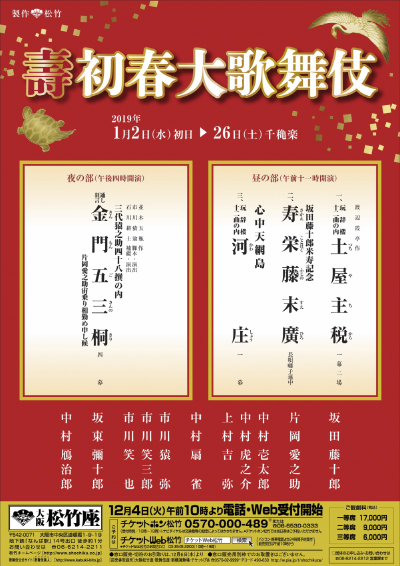 |
| National Theatre (T˘ky˘) |
| Dates | 3 ~ 27 January 2019 |
| Program | |
| Casting |
Living National Treasure Onoe Kikugor˘, Nakamura Tokiz˘, Onoe Kikunosuke, Onoe Sh˘roku, Band˘ Rakuzen, Ichikawa Danz˘, Band˘ Hikosabur˘, Kataoka Kamez˘, Band˘ Kamez˘, Kawarasaki Gonjűr˘, Ichimura Manjir˘, Nakamura Baishi, Nakamura Mantar˘, Ichimura Takematsu, Onoe Ukon, Ichimura Kitsutar˘, Terajima Maholo, Terajima Kazufumi |
| Comments |
Revival at the National Theatre of Namiki Gohei I's 1779 drama "Sode Nikki Banshű Meguri". This Otowaya-powered revision is entitled "Himeji-j˘ Oto-ni Kiku Sono Ishizue".
|
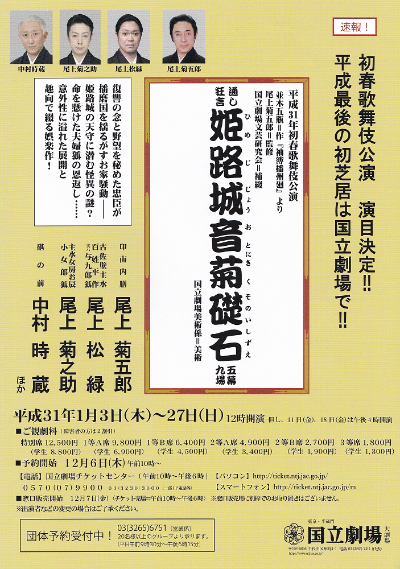 |
| Kabukiza (T˘ky˘) |  |
| Dates | 2 ~ 26 January 2019 Kotobuki Hatsuharu ďkabuki Congratulation Early Spring Grand Kabuki |
| MatinÚe |
Kichirei Kotobuki Soga (Shigitatsusawa Taimen) |
| Evening | |
| Casting |
Living National Treasure Nakamura Kichiemon, Living National Treasure Nakamura T˘z˘, Matsumoto Haku˘, Nakamura Shikan, Matsumoto K˘shir˘, Nakamura Jakuemon, Ichikawa Ennosuke, Nakamura Shichinosuke, Nakamura Baigyoku, Nakamura Kaishun, Nakamura Fukusuke, Kataoka Hidetar˘, Nakamura Karoku, Nakamura Matagor˘, Ichikawa Komaz˘ |
| Comments |
The traditional two programs for the New Year Grand Kabuki at the Kabukiza.
|
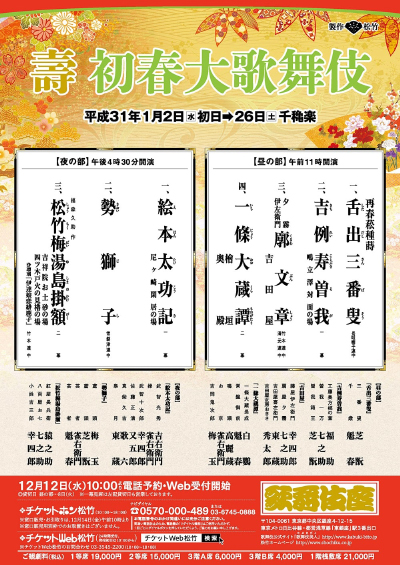 |
| Shinbashi Enbuj˘ (T˘ky˘) |  |
| Dates | 3 ~ 27 January 2019 Hatsuharu Kabuki K˘en Early Spring Kabuki Performances |
| MatinÚe | |
| Evening |
Natorigusa Hana no Jűichidai |
| Casting |
Ichikawa Ebiz˘, Kataoka Takatar˘, Ichikawa Sadanji, Ichikawa Udanji, Nakamura Shid˘, ďtani Tomoemon, Kataoka Ichiz˘, Ichimura Kakitsu, Ichikawa Sai'nyű, Nakamura Kotar˘, Ichikawa Omez˘, Ichikawa Kudanji, Ichikawa Otora, ďtani Hiromatsu, Kataoka Matsunosuke, Horikoshi Kangen, Horikoshi Reika |
| Comments |
The traditional New Year Kabuki at the Shinbashi Enbuj˘ with a troupe led by the young star Ichikawa Ebiz˘.
|
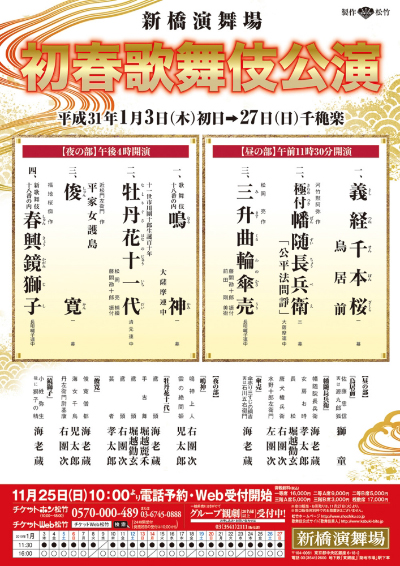 |
|
|||
| Dates | 2 ~ 26 January 2019 Shinshun Asakusa Kabuki New Year Asakusa Kabuki |
||
| MatinÚe |
Otoshidama (Nenshi Goaisatsu) |
||
| Evening |
Otoshidama (Nenshi Goaisatsu) |
||
| Casting |
Nakamura Kinnosuke, Onoe Matsuya, Band˘ Minosuke, Nakamura Kash˘, Band˘ Shingo, Nakamura Yonekichi, Nakamura Hashinosuke, Nakamura Hayato, Nakamura Tanenosuke, Nakamura Tsurumatsu, Nakamura Umemaru |
||
| Comments |
The yearly show for young promising actors at the Asakusa K˘kaid˘ in Asakusa, a lively and colorful neighboorhood that keeps the scent of old Edo.
|
||
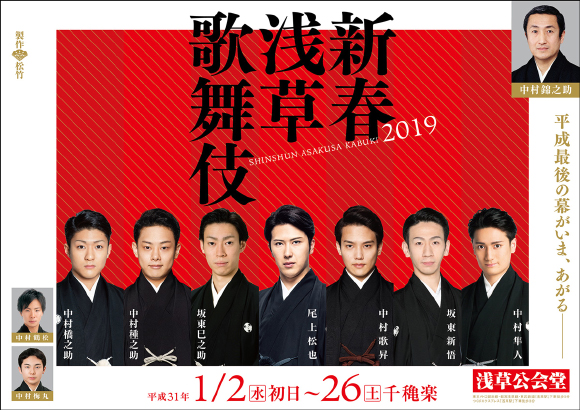 |
|
|||
| Dates | 4 ~ 14 January 2019 Zenshinza Tokubetsu K˘en Zenshinza Special Performances |
||
| Program |
Ura Nagaya S˘d˘ki |
||
| Casting |
Kawarasaki Kunitar˘, Arashi Yoshisabur˘, Fujikawa Yanosuke, Matsunami Kihachir˘, Tadamura Shin'ya |
||
| Comments |
The traditional Zenshinza New Year performances in Ky˘to. Not at the Minamiza, as it used to be, but at the Ky˘to Gekij˘. "Ura Nagaya S˘d˘ki", which was written by the veteran movie director Yamada Y˘ji and was premiered in May 2017 at the National Theatre, is based on two famous rakugo stories, "Rakuda" and "Ido no Chawan". |
||
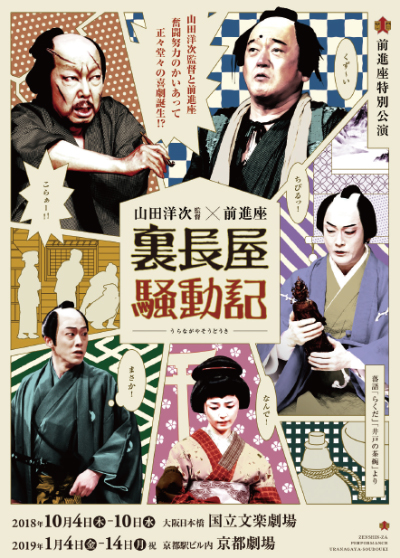 |
|
|
| Contact | Main | Top | Updates | Actors | Plays | Playwrights | Programs | Links | FAQ | Glossary | Chronology | Illustrations | Prints | Characters | Derivatives | Theaters | Coming soon | News |
